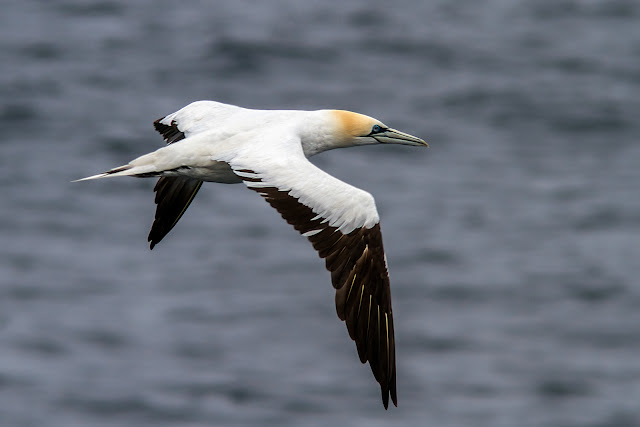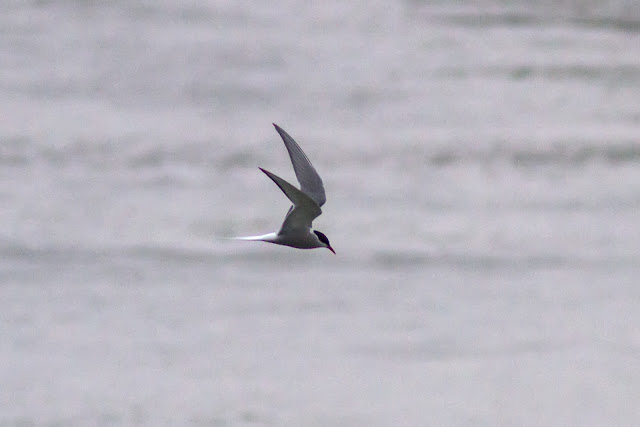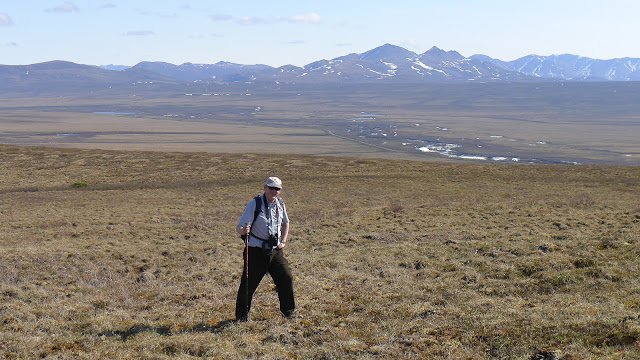June 26 – We fly
from Calgary to Charlottetown, PEI via Montreal. Our arrival in Charlottetown
is not too auspicious, as we break through the clouds shortly before landing,
and dodge the raindrops as we scurry into the terminal building. Brian picks up
our Ford Escape which we’ll be using for ten days, and we drive the short
distance to the Super 8 motel. Given the weather, there is no point in any
evening birding and we have a fish supper at Maggie’s Family Restaurant across
the parking lot from the motel.
June 27 – Making
up for lost time we have a quick breakfast in the motel lobby and head for
Prince Edward Island National Park, a 50-km stretch of PEI’s north coast. We
will need to get as much birding done as we can before catching the ferry from
Souris at 2 PM, and fortunately the rain has stopped overnight.
At various points
along the shore between Cavendish and Brackley Beach we pick up several sea
birds including the majestic Northern Gannet, which we will see in considerable
numbers over the next few days.
 |
| Northern Gannet |
In some wooded
areas we find a number of songbirds including an excellent look at a
White-throated Sparrow.
 |
| White-throated Sparrow |
A hiking trail called Bubbling Springs had been recommended as a good birding spot, and we hear our first Winter Wren of the year there, but the trail is thick with mosquitos so we retreat to the car and head to the next birding locale, Pigot’s trail at Mount Stewart. No mosquitos there, as they have been swept away by the freshening breeze. Birding is accordingly quiet so we head for Souris and have lunch in a café by the harbour.
The ferry
Madeleine plies the Gulf of St. Lawrence daily between Souris, PEI and Cap aux
Meules, Quebec, on the Iles de la Madeleine, a 5-hour voyage. Brian had
selected the Iles de la Madeleine (known in English as the Magdalen Islands) as
our Quebec destination for the year, an unorthodox choice but an inspired one.
The 135 km voyage to this remote outpost of Quebec is very smooth, with few
birds except as we rounded the eastern tip of PEI and on the approach to the
islands. Brian and Phil slipped inside for a coffee and missed a couple of
Sooty Shearwaters spotted by Ray and Mike. We are back on deck to see the first
of many Black-legged Kittiwakes and a couple of Humpback Whales and enjoy the
final approach into the harbor at Cap aux Meules.
The day ends with
dinner at our comfortable hotel, and a tally of our bird and mammal list for
the day – 57 bird species recorded in PEI, and 12 in Quebec, and the whales the
only notable mammals.
June 28 – Today we begin our exploration of the Madeleine island archipelago , consisting of about twelve islands, six of which are connected by sand dunes by the 65 km long Hwy 199.
 |
| Iles de la Madeleine |
Before breakfast we bird the wooded slopes on Cap aux Meules Island, tallying over 20 species, several being heard-only, but we do get good looks at a Winter Wren. By late June, many birds are no longer singing with much vigour and two of our target birds, Yellow-bellied Flycatcher and Mourning Warbler prove elusive and remain on our wanted list at the end of our stay on the islands.
 |
| Sand dunes on Madeleine Islands |
After breakfast
we head north-east along Hwy 199, finally reaching Grand Entrée at lunchtime.
Along the way we explore the dunes and marshes and take in the small
communities and harbours, watching the fishing boats disgorging their catches
of scallops, crabs and lobsters. We have excellent looks at both Common and
Arctic Terns, Black and White-winged Scoters, Black Guillemots, Common
Murres and several species of sparrow
(but unfortunately no Nelson’s).
 |
| Black Guillemot |
 |
| Swamp Sparrow |
A family of Red
Foxes provides much amusement. This mammal is seen frequently on the islands.
In contrast to the fertile soil of PEI, we see few signs of agriculture here.
Two dead humpback whales on a long sandy beach are less appealing.
On our return
south we check several beaches for signs of Piping Plover, without success.
Scoping an offshore rocky island reveals both the numerous Double-crested
Cormorants and a number of Great Cormorants. Arriving back at Cap aux Meules,
we go into the office of Excursions en Mer to enquire about the possibility of
a trip by zodiac to Ile Brion tomorrow. We are in luck, as the weather
conditons look favorable and we will be on the second trip which will leave
Grand Ile at 11:00 AM. Charming Pauline explains what the trip involves, and
tells us she will be acting as our guide on the island tomorrow. She also tells
us where to find the scarce Piping Plover on Cap-aux Meules.
We have dinner at
a funky café at Cap Etang du Nord, and head home for an early night to ensure a
good night’s sleep before tomorrow’s adventure.
 |
| An unusual dining experience at Le Salon de The Le Flaneur |
June 29 – After a
quick breakfast at Tim Horton’s, we do a couple of hours birding in the south before
heading up to the harbor at Grand Ile. We are delighted to find a Piping Plover
very close to where we park the vehicle by the Dune du Nord, a long expanse of
sand dunes. Less delightful is watching a man walk his dogs right where the
endangered plover is nesting.
 |
| Piping Plover |
 |
| Black-legged Kittiwake |
 |
| Part of a Large Colony of Common Murres |
 |
| Atlantic Puffin |
 |
| Razorbills |
We land on a rocky beach, where we are greeted by Pauline. The morning group leaves on the zodiac and we are left behind to enjoy the peace of the island, and a picnic lunch on the beach where the seals can be seen close up.
 |
| Our guide Pauline communes with Harbour Seals |
We walked to the
beach across beautiful meadows and a forest of stunted trees, past the
lighthouse. descending the cliff down a narrow gully with a rope to hang on
to. Almost all of the uninhabited island is now an ecological reserve,
returning to the state it was in when discovered by Jacques Cartier in 1534.
The island had been inhabited by one family for about a hundred years until the
1960s, as well as fishermen who lived there in the summer months.
 |
| Walking across the meadow at Ile Brion |
 |
| On the beach at Ile Brion |
We spend the next
three hours returning to the south end of the island chain, checking out a few
birding spots we haven’t visited yet, and enjoying the views under glorious
sunny skies. A Black-headed Gull is a surprise sighting.
We have dinner at
a lobster “factory”, and spend our last night on the Iles de la Madeleine with
many happy memories.
 |
| Evening on Iles de la Madeleine |




































